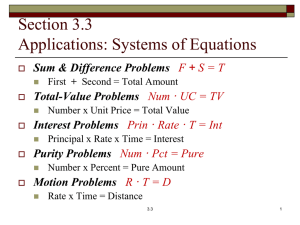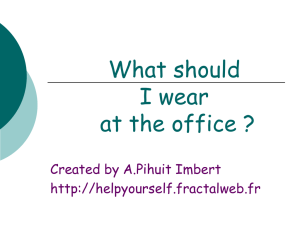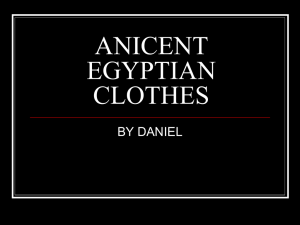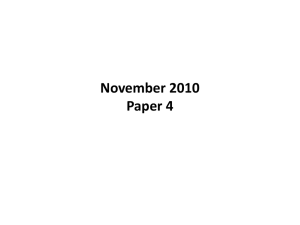Personal Project Process Journal
advertisement
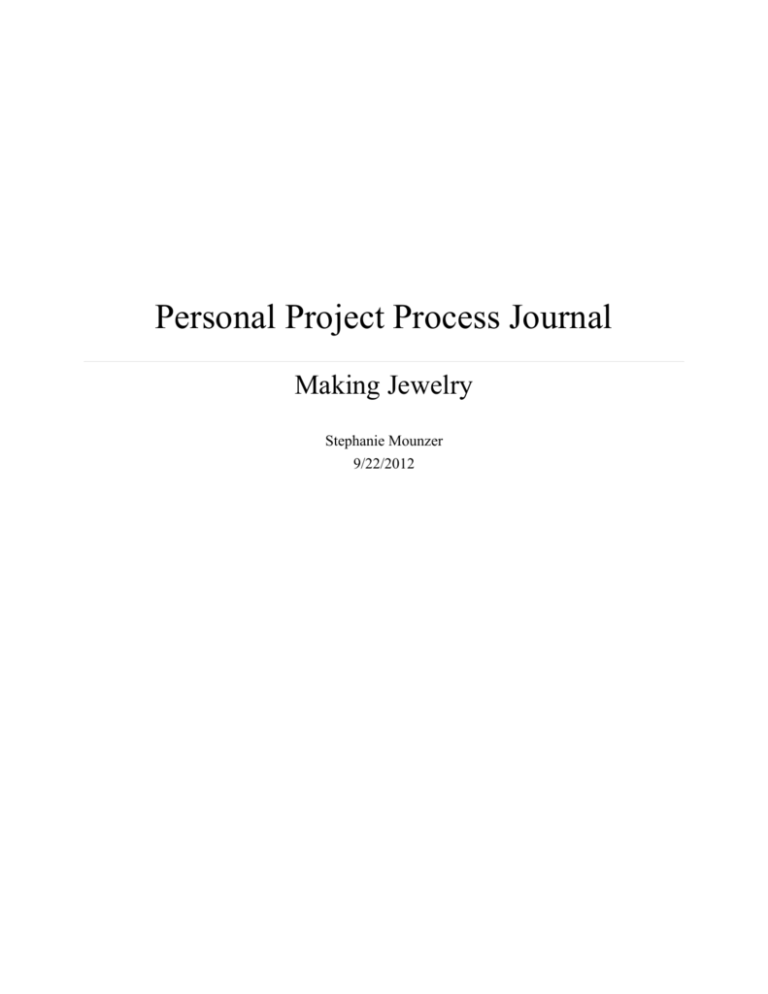
Personal Project Process Journal Making Jewelry Stephanie Mounzer 9/22/2012 Stephanie Mounzer Personal Project Process Journal September Saturday September 22nd, 2012 This week I decided that my personal project idea would be making jewelry. This includes bracelets, necklaces, earrings and rings. I took a class downtown at Vancouver Community College from 6:30-9:30 pm. I was expecting a regular classroom with desks and a few tools for making jewelry, but instead there were workshop desks with drills, torches, and workshop tools. The lesson included a long introduction on the tools and how to use them including safety. What I learned from this class was that I don’t want to base my project around the carving and molding of jewelry. Instead, I want to focus on the beading, weaving, braiding and design aspect of making jewelry. Today, I took a class at a bead store in Kitsilano called Country Beads. The lesson was from 10:30-12:30 am. I learned how to make a basic bracelet and a pair of earrings. I found out that just making a basic bracelet with some beads on it isn’t as easy as it looks. You have to match the colours and keep the beads in proportion. Also, attaching the clasp on the bracelet and earring hooks is tricky and takes patience. While I was there I looked around at the beads, magazines, and displays and was inspired to make my own jewelry. The bracelet/pair of earrings I made today: Monday September 24th, 2012 Today I set a clear and detailed goal for my personal project. My goal is to make 20 pieces of durable and visually appealing jewelry. I will use new and challenging techniques to create my jewelry. The 20 pieces will include 4 necklaces, 10 bracelets, and 6 pairs of earrings. I will include 3 styles of jewelry in my project; beading, wirework, and macramé. For beading, I will make 3 necklaces, 3 bracelets, and 3 earrings. For wirework, I will make 1 necklace, 1 bracelet, and 3 earrings. For macramé, I will make 6 bracelets. The reason I am making the fewest pieces in the style of wirework is because it is very time consuming, taking several hours to finish certain pieces. Stephanie Mounzer Personal Project Process Journal I decided not to include rings in my project because all there is to making a ring is gluing beads or other decorations to a metal ring, which isn’t difficult or challenging and involves little skill. Thursday September 27th, 2012 Today, I did a jewelry class at Vancouver Career College. There were about 12 people in the class and I learned about silversmithing and many advanced tools, such as saws and torches. Silversmithing is a form of making jewelry, but it is more about making the silver, gold, copper and bronze elements of jewelry (chain, hooks, rings) instead of wirework, beading, or macramé. Silversmithing involves many tools like hammers, drills and filers. This is not the type of jewelry I want to make for my project; I want to make jewelry that has colour and texture and focus on the design side instead of the making of the base of the jewelry. I couldn’t go into silversmithing because I don’t have the tools or the skills. Sunday September 30th, 2012 The area of interaction I chose to focus on for my personal project is Human Ingenuity. This AOI explores the process and product of creativity. While making jewelry, the process is very detailed and intricate, resulting in an interesting and creative product. Human Ingenuity is more than just creating the product, but also experiencing and reflecting on the creative process. After I make a piece of jewelry, I can reflect on what I like and don’t like about it, which will help improve my next piece. My timeline for my personal project: Date: October 9th – November 1st Goal: Research Amount of time per week Approx. 1.5 hours each Stephanie Mounzer November 1 – November 22 st November 23rd – January 9th Personal Project th Visiting bead stores Looking at websites/books Planning and designing jewelry Practicing basic jewelry techniques Making jewelry Process Journal week (4.5 hours in total) Approx. 4 hours each week (12 hours in total) Make 4 pieces of jewelry each week (4 pieces x 5 weeks = 20 pieces) Approx. 6 hours each week (24 hours in total) th st January 9 – February 1 Outlining the project report Approx. 0.5 hours each week (1.5 hours in total) st th February 1 – February 15 Writing the rough draft of the Approx. 3 hours each project report week (6 hours in total) th th February 15 – March 4 Writing the final draft of the Approx. 5 hours each project report week (10 hours in total) Approx. total amount of time: 58 hours Throughout the process I may need to make changes to this timeline as my schedule changes. To measure the success of my product, the jewelry will need to be visually appealing, durable, and something I would be proud to wear or give away as a gift. To be visually appealing, the jewelry should be proportionate, the colour scheme should have unity and harmony, and there should be an element of balance. For the pieces to be durable, they should be strong enough not to break or fall apart. To wear the jewelry myself or give away as a gift, the jewelry should be interesting, but not too busy or exaggerated. The jewelry should be able to complement almost any outfit. October Sunday October 7th, 2012 Today I took another jewelry class at S&S Studios, a jewelry store in Burnaby. I took two classes; basic and intermediate wirework techniques. I learned how to use chain nose, flat nose, and round nose pliers as well as wire cutters (1st picture). I learned about wire and the different tools you can use to maneuver wire into different shapes. There are several different sizes of wire; 26G (Gauge), 24G, 22G, etc. Larger numbers are thinner wire and smaller numbers are thicker. Thinner wire is easier to maneuver but more fragile and easy to snap or bend out of shape overtime. Thicker wire is hard on the hands but stays in place overtime and doesn’t bend out of shape. I learned techniques like wire wrapping, making swirls, loops, hooks and other designs. Using these techniques I can make wire wrapped necklaces and bracelets (2nd picture), and even my own earring hooks (5th picture). Wire wrapped techniques can be applied to all types of jewelry, such as beading and macramé, and not just wirework. Stephanie Mounzer Personal Project Process Journal Friday October 12th, 2012 Today I gathered some valuable sources from the internet and took notes from them. I also wrote out a Works Cited using Purdue Owl to help me. I learned the steps to making basic beaded jewelry and researched several macramé patterns. I looked at different colour combinations, styles/shapes/sizes of beads, types of jewelry, and inspiration ideas. I mainly took notes but haven’t started writing my research paper yet. Friday October 19th, 2012 Stephanie Mounzer Personal Project Process Journal This week, I finished researching and writing a rough draft for my research paper. Also, I had my meeting with my supervisor, Ms. McTavish. She gave my some good advice on things I should include in my research paper. For example, if I plan on donating my jewelry to a charity at the end of the project, then I should research some charities and include that information in my research paper. Also, I should write out a detailed materials list of the tools, beads, and string I will need as well as talk to my parents and make a budget for the project. I hope to continue working on my research paper to have it done by November 1st. Sunday October 28th, 2012 This week I researched 5 charities that I could possibly donate my jewelry to as well as all the materials I will need and the approximate budget. I have finished my rough draft and will need to set aside some time to write out my final copy. Looking back on my timeline I wrote in September, I am still on track and managing to keep up with deadlines. November Saturday November 3rd, 2012 Today I went to Country Beads, a bead shop on West 4th in Kitsilano. There is an endless collection of beads there. There are pearls, crystals, opaque, clear, shiny, dull, and all different colours, shapes and sizes. I came into the store without a plan in mind; I didn’t know how many beads I needed or the colour scheme I wanted to stick too. To make a certain piece of jewelry you need a certain amount of beads, and the colours need to flow together, with an element of balance. It is hard to pick all the right beads without creating a detailed plan for the piece of jewelry first. I took a good look around the store for a few hours picking out some of my favorite beads just to get me started. I also bought some basic things I will need for everything I make, such as wire, beading wire, clasps, earring hooks. I got to know the store and where certain beads are so next time I visit the store I will be more productive and come with a detailed plan for each of my pieces, including how many beads I need, the colours, the sizes, and the materials I will need. Sunday November 4th, 2012 Today I went to Michaels and visited the bead section. Earlier today, I went through my book on beading called Easy Beading and bookmarked all of the pages of the jewelry pieces that I liked and would like to make something similar. This way, I thought I would have a clearer plan in mind when I went shopping for beads. At Michaels, there were many beads but I prefer the selection at Country Beads. I managed to buy string for my macramé jewelry but I didn’t buy any beads. Later today, I went to fusionbeads.com and looked at all the jewelry on the website and got some inspiration. I looked through the Inspiration Projects tab and saw many examples of Stephanie Mounzer Personal Project Process Journal necklaces, bracelets, and earrings. This website was designed to promote a store, help people complete jewelry projects, and run a blog on current news related to jewelry. Saturday November 24th, 2012 Today I went to the bead shops at Granville Island and looked at all the beads there. At Bead Works, there were thousands of beads and some display jewelry that I got some inspiration from. While I was there, I realized I like Country Beads better than Bead Works for several reasons. The selection is smaller and less overwhelming, the beads are well organized and in clear sections, and it isn’t as busy there so it’s easier to work on pieces at the table they have set up. At Country Beads, I picked out several beads and started making jewelry at the table they have set up in their store. I was there for a few hours, picking out beads, laying them out on a bead board, finding combinations, and I even made a few pieces of jewelry. I brought my bead board, box of beads and notebook from home that has all my designs and planning in it. I laid them out on the table and started to make patterns on the bead board, making reference to my notebook, and seeing how I could incorporate the beads I’d already bought. I found this to be very effective at making jewelry because without having a bead board, a notebook with plans, and my beads from home it can be very hard to make a jewelry design from scratch and to know how many beads you need, the tools, and other materials, such as clasps and chains. I think this is the problem I was having before when I came to the bead stores before without having a plan in mind. I was confused at what to do with the thousands of beads. When I got home, I finished one pair of earrings that I had been working on earlier, another pair of earrings, and a necklace. After today, I am done 4 of 20 pieces of jewelry. Stephanie Mounzer Personal Project Process Journal Sunday November 25th, 2012 Today I continued making jewelry. I set up my bead board, beads, and tools at my kitchen table and worked for a few hours. I managed to finish a bracelet and three pairs of earrings. I also went to Michaels today and picked up a few more materials that I needed, including gold crimps, clasps and split rings. I used a gold clasp on my bracelet but looking back on it now I realized it is too large. Also, the Stephanie Mounzer Personal Project Process Journal theme of the bracelet is gold but I used silver wire guards because I had no gold ones. I think I would like to redo this bracelet with a smaller clasp and gold wire guards. Another time I had to redo my jewelry was when I was making a pair of earrings today. The earrings are a chandelier style with gold chain and pink and black beads. The gold chain was too long so I cut the chain with my wire cutters and restrung the pink beads to make the earring more proportionate. I’ve learned that in jewelry making there are going to be several times where I’ve made mistakes and I need to remake a piece. December Saturday December 8th, 2012 Today, I went to fusionbeads.com and browsed through the several different jewelry techniques and tutorials they have on their website. I decided to alter my plan; instead of making a set number of pieces, I will complete a certain number of different techniques that are each different and challenging. The wire working techniques I will incorporate include a simple loop, wire wrapping, a wrapped link, wire wrapping a triangle bail, and wire wrapping around a bead. The cord techniques include a macramé bracelet with adjustable closure and a wrapped cord bracelet. The peyote stitch techniques include a flat, even count peyote stitch with and a peyote stitch bezel. I will also include a netted bracelet. 6 of these Stephanie Mounzer Personal Project Process Journal techniques are complicated and difficult and the others are basic techniques that can be applied to several different types of jewelry. Saturday December 15th, 2012 This past week, I have been working on the peyote stitch bracelet. I have had to restart it 5 times because this design is very intricate and hard to master. Just one small mistake can ruin the look of the whole bracelet. I snapped the needle, broke the thread, and threaded beads incorrectly, along with several other mistakes. Finally I managed to complete the peyote stitch bracelet, and I am quite pleased with it. This bracelet took approximately 6-7 hours to complete. Saturday December 23rd, 2012 I have completed a second new technique this week; wire wrapping around a bead. I found this technique very difficult, but not as difficult as the peyote stitch, which I began to become impatient with. I redid the bracelet twice to get a feel for working with wire and shaping it around the bead, twisting it, and making a chain. The second time I made the bracelet the handiwork was cleaner and the bent wire was smoother. Sunday December 27th, 2012 Stephanie Mounzer Personal Project Process Journal I have completed the netted bracelet with blue and black beads. This stitch is similar to the peyote stitch in that it involves threading and weaving, but it is less difficult and if you make a mistake, it doesn’t ruin the rest of the bracelet and can be fixed. I have also completed the macramé bracelet with blue thread and crystal beads. The knotting and adjustable clasp on this bracelet are difficult, and I ended up untying all the knots and starting again. These projects are detail oriented and very tricky and intricate. January Thursday January 3rd, 2013 In the past week, I have completed my project. I have made 4 necklaces, 7 pairs of earrings, and 9 bracelets (20 pieces total). My original goal was to have made 10 bracelets, 6 earrings and 4 necklaces. Although my end result was different from my original goal, I still made 20 pieces, which was my intention. Making jewelry turned out to be harder than I thought it would be. Trying different techniques and trying to get it right the first time is difficult. There were many times when I undid the entire piece and remade it. I learned many valuable techniques and by the end of making jewelry I didn’t need to follow step by step instructions; I could make almost anything just from an idea in my head. Next I will start writing my Project Report Rough Draft. Friday, January 18th, 2013 This week I had a meeting with my Personal Project supervisor, Ms. McTavish. We discussed the project report and all that it entails. We went through each objective; Define the Goal, Select Sources, Apply Information, Achieve the Goal, and Reflect on Learning. We talked about how I can use my previous process journals as well as my research paper to help me write the project report. We set a timeline to help keep me on track. I have from now to February 15th to hand in the rough draft of my project report. In the first week, I can write Define the Goal and Selection of Sources. The next week, I can write Apply Information and Achieve the Goal. The third week I can write Reflect on Learning and my Works Cited. Finally, I can include Appendices, a Table of Contents, and a Title Page. This plan will hopefully be manageable keep me on track. This way, I can manage my schoolwork and other activities while keeping up with my Personal Project. February Friday, February 1st, 2013 In the past two weeks, I wrote out an outline for my project report, and started writing Define the Goal, Select Sources and Apply Information. I am slightly behind, because by now I had planned to write Achieve the Goal, but I haven’t yet. Also, Define the Goal, Select Sources, and Apply Information are not Stephanie Mounzer Personal Project Process Journal fully written. I still want to go back and edit these sections and add more to them. Writing Select Sources and Apply Information have been the two most difficult so far. I find it challenging to write about how my sources directly impacted my project, and how I applied the information from my sources to achieve my goal. When writing the project report, I have been referring to the rubrics as well as a sample project report titled “Ridding Sorrows for a Better Tomorrow.” This project is a good example because the levels achieved on its assessment are four 4’s and two 3’s of a possible 4 for criterions A to G. I have also referred to the Student Guide to the Personal Project also has a detailed outline for what to include in each of the sections. Friday, February 15th, 2013 Today I finished writing my project report. In the past two weeks, I had another meeting with my supervisor, Ms. McTavish, to discuss where I was at in writing the report and to adjust the timeline we had set. We made another timeline that would help me get my rough draft handed in on time. I followed the timeline and it was very helpful. I managed to finish writing each of the sections as well as finishing the Title Page, Table of Contents, and Works Cited. Writing my Works Cited helped me learn about MLA formatting. I learned how to source and cite books and websites correctly. I now have two weeks for my supervisor to mark my rough draft and to make corrections. March Sunday, March 3rd, 2013 Last Monday Ms. McTavish gave me back my rough draft of the project report after editing and marking it. She had many helpful ideas and notes on my project report. She pointed out areas where I should focus on and sections that were lacking. My lowest section was Apply Information (level 2) and my highest sections were Achieve the Goal and Reflect on Learning (level 3/4). I am aiming to get all of my sections to at least a level 3. I spent the past week making corrections and editing my project report to get the areas in which I got a level 2 or 2/3 up to at least a 3. I wrote my entire project report out again; I found that this way was easier to catch mistakes I had made as well as find areas which I wanted to improve on. When I finished writing, my project report was about 3,800 words, which was 300 words over the limit. I had to go through and take out a few sentences to reach 3,500 words. I decided to include a Works Consulted as well as a Works Cited because I wanted to show that I used and made reference to several sources throughout my project, not just the few that I cited. My project report is due tomorrow, but I still want to look over it some more and make sure that I will achieve at least a level 3 in each of the criterions. Therefore, I asked Ms. McTavish for an extension Stephanie Mounzer Personal Project Process Journal until this Friday. This will give me time to edit the report some more so that I am confident in the work I am handing in.

